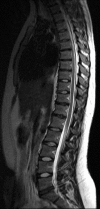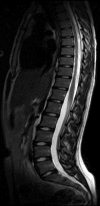Disc degeneration on MRI is more prevalent in young elite skiers compared to controls
- PMID: 28409199
- PMCID: PMC5754419
- DOI: 10.1007/s00167-017-4545-3
Disc degeneration on MRI is more prevalent in young elite skiers compared to controls
Abstract
Purpose: Evidence-based facts regarding spine abnormalities and back pain are needed in order to develop rehabilitation programs and prevent spine injuries in young skiers. The aim therefore is to identify MRI changes in the thoraco-lumbar spine and the lifetime prevalence of back pain, as well as the association between them, in young skiers compared to non-athletes.
Methods: Seventy-five young elite alpine and mogul skiers, age range 16-20 years, were compared with 27 non-athletic controls. All subjects underwent spinal MRI and answered back pain questionnaires.
Results: Fifty-six percent of skiers had at least one disc Pfirrmann grade ≥3 compared to 30% of controls (p = 0.027). Schmorl's nodes (46%) and disc height reduction (37%) were significantly more prevalent in skiers compared to controls (0%) (p < 0.001). When all parameters were combined together, skiers had significantly higher rate of radiological changes than controls, 82% compared to 54% (p = 0.007). The mean number of discs with Pfirrmann grade ≥3 was 1.1 per individual in skiers (median 1, range 0-6) versus 0.6 in controls (median 0, range 0-3). There was no significant difference in lifetime prevalence of back pain between skiers (50%) and controls (44%) (n.s.). MRI abnormalities in skiers did not correlate with lifetime prevalence of back pain. Skiers had a better health perception than controls (p = 0.026).
Conclusion: Alpine skiers have more degenerative disc changes compared to non-athletes, but these changes do not correlate with the lifetime prevalence of back pain. Lifetime prevalence of back pain is not significantly different between the groups; however, skiers report more severe pain on VAS score.
Level of evidence: II.
Keywords: Athletes; Disc degeneration; MRI; Schmorl’s nodes; Skiers.
Conflict of interest statement
Conflict of interest
All other authors declare that they have no conflict of interests.
Funding
This study was funded by The Medical Society of Gothenburg, Handlanden Hjalmar Svenssons Research Foundation and Doktor Felix Neuberghs Foundation, Carl Bennett AB, and Swedish National Centre for Research in Sports.
Ethical approval
All procedures performed in studies involving human participants were in accordance with the ethical standards of the regional and institutional research committee and with the 1964 Helsinki declaration and its later amendments or comparable ethical standards.
Informed consent
Informed consent was obtained from all individual participants included in the study.
Figures
Similar articles
-
Back pain and MRI changes in the thoraco-lumbar spine of young elite Mogul skiers.Scand J Med Sci Sports. 2017 Sep;27(9):983-989. doi: 10.1111/sms.12710. Epub 2016 Jul 1. Scand J Med Sci Sports. 2017. PMID: 27367529
-
No Significant Change in MRI Abnormalities or Back Pain Prevalence in the Thoraco-Lumbar Spine of Young Elite Skiers Over a 2-Year Follow-Up.Open Access J Sports Med. 2022 Aug 18;13:69-76. doi: 10.2147/OAJSM.S366548. eCollection 2022. Open Access J Sports Med. 2022. PMID: 36003328 Free PMC article.
-
Different disc characteristics between young elite skiers with diverse training histories revealed with a novel quantitative magnetic resonance imaging method.Eur Spine J. 2021 Jul;30(7):2082-2089. doi: 10.1007/s00586-021-06869-2. Epub 2021 May 19. Eur Spine J. 2021. PMID: 34013394
-
The Prevalence of Abnormalities in the Pediatric Spine on MRI: A Systematic Review and Meta-Analysis.Spine (Phila Pa 1976). 2020 Sep 15;45(18):E1185-E1196. doi: 10.1097/BRS.0000000000003527. Spine (Phila Pa 1976). 2020. PMID: 32355138
-
The thoracolumbar spine in young elite athletes. Current concepts on the effects of physical training.Sports Med. 1992 May;13(5):357-64. doi: 10.2165/00007256-199213050-00005. Sports Med. 1992. PMID: 1533052 Review.
Cited by
-
Snow sports-specific extension of the IOC consensus statement: methods for recording and reporting epidemiological data on injury and illness in sports.Br J Sports Med. 2024 Dec 23;59(1):8-23. doi: 10.1136/bjsports-2024-108720. Br J Sports Med. 2024. PMID: 39515849 Free PMC article.
-
Is There a Relationship Between Workload and Occurrence of Back Pain and Back Injuries in Athletes?Front Physiol. 2020 Jul 24;11:894. doi: 10.3389/fphys.2020.00894. eCollection 2020. Front Physiol. 2020. PMID: 32792989 Free PMC article. Review.
-
Longitudinal Assessment of Intersegmental Abnormalities in the Lumbar Spine of Adolescent Competitive Alpine Skiers Over 48 Months.Am J Sports Med. 2025 Jan;53(1):202-209. doi: 10.1177/03635465241295384. Am J Sports Med. 2025. PMID: 39741483 Free PMC article.
-
Low Back Pain and Lumbar Degeneration in Japanese Professional Baseball Players.Orthop J Sports Med. 2022 Oct 12;10(10):23259671221125513. doi: 10.1177/23259671221125513. eCollection 2022 Oct. Orthop J Sports Med. 2022. PMID: 36250034 Free PMC article.
-
Detailed MRI evaluation of the spine: a 2-year follow-up study of young individuals reporting different training doses.Eur Spine J. 2023 Dec;32(12):4145-4152. doi: 10.1007/s00586-023-07961-5. Epub 2023 Oct 10. Eur Spine J. 2023. PMID: 37815636
References
-
- Alricsson M, Werner S. Self-reported health, physical activity and prevalence of complaints in elite cross-country skiers and matched controls. J Sports Med Phys Fitness. 2005;45:547–552. - PubMed
Publication types
MeSH terms
LinkOut - more resources
Full Text Sources
Other Literature Sources
Medical
Research Materials
Miscellaneous



